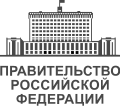
Back President d'o Gubierno de Rusia AN رئيس وزراء روسيا Arabic رئيس وزرا روسيا ARZ Presidente del Gobiernu de Rusia AST Rusiya Baş naziri Azerbaijani Старшыня Урада Расійскай Федэрацыі Byelorussian Старшыня Ўраду Расейскай Фэдэрацыі BE-X-OLD Министър-председател на Русия Bulgarian Premijer Rusije BS Primer ministre de Rússia Catalan
| Chairman of the Government of the Russian Federation | |
|---|---|
| Председатель Правительства Российской Федерации (Russian) | |
 Logo of the Government of Russia | |
 | |
since 16 January 2020 | |
| Council of Ministers of Russia Government of Russia | |
| Style |
|
| Abbreviation | PMOR, PMORF |
| Member of | |
| Reports to | |
| Seat | White House, Moscow |
| Nominator | President |
| Appointer | President (with the approval of the State Duma) |
| Term length | No fixed term |
| Constituting instrument | Constitution of Russia |
| Precursor | Chairman of the Council of Ministers of the Soviet Union (1923–1991) |
| Formation |
|
| First holder | Sergei Witte |
| Unofficial names | Prime Minister |
| Deputy | |
| Salary | US$105,000 annually[2] |
| Website | premier |
 |
|---|
The chairman of the government of the Russian Federation,[a] also informally known as the prime minister,[b] is the head of government of Russia and the second highest ranking political office in Russia. Although the post dates back to 1905, its current form was established on 12 December 1993 following the introduction of a new constitution.
Due to the central role of the president of Russia in the political system, the activities of the executive branch (including the prime minister) are significantly influenced by the head of state (for example, it is the president who appoints and dismisses the prime minister and other members of the government; the president may chair the meetings of the cabinet and give obligatory orders to the prime minister and other members of the government; the president may also revoke any act of the government). The use of the term prime minister is strictly informal and is never used in the constitution.
Mikhail Mishustin is the current prime minister. He was appointed on 16 January 2020 after Dmitry Medvedev and the rest of the government resigned the previous day.
Cite error: There are <ref group=lower-alpha> tags or {{efn}} templates on this page, but the references will not show without a {{reflist|group=lower-alpha}} template or {{notelist}} template (see the help page).
